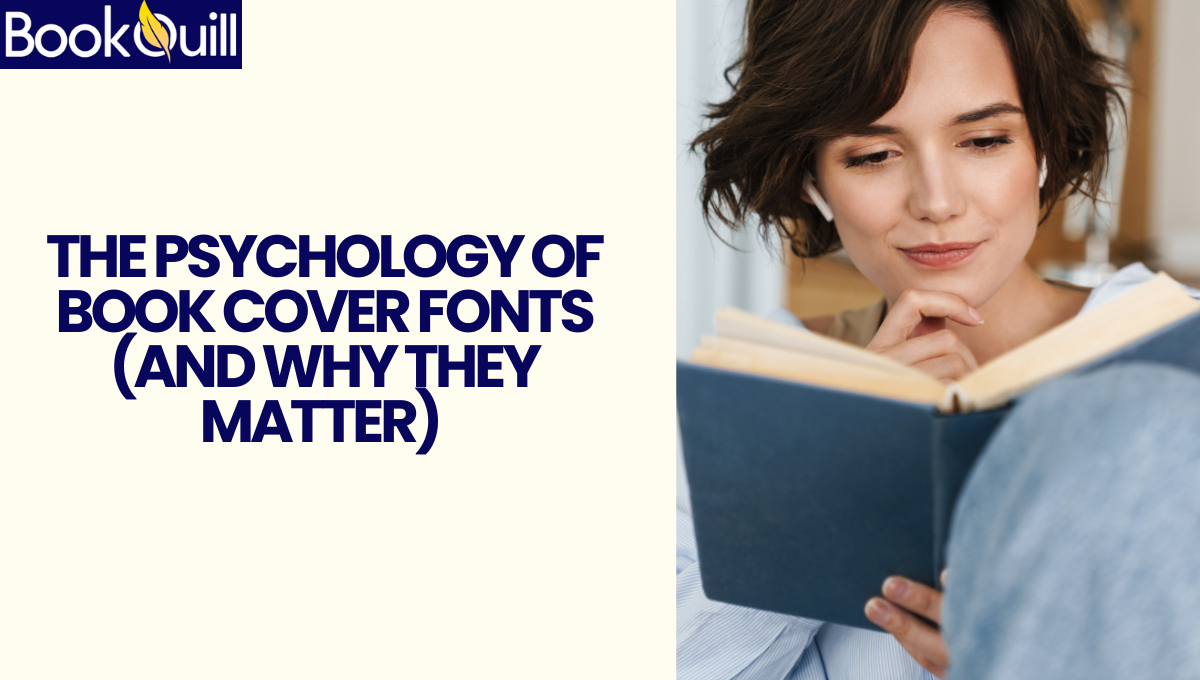The Psychology of Book Cover Fonts (And Why They Matter)
You can’t judge a book by its cover, but you can sure sell a bunch of books if you have...

You can’t judge a book by its cover, but you can sure sell a bunch of books if you have a good one – Jayce O’Neal
When you are designing your book cover or simply thinking, “Hmm, I shouldn’t be wasting too much time on the cover because it’s the story that’s going to attract readers,” well, I would just say to take a step back and think about what Jayce O’Neal said.
When browsing libraries or online marketplaces, one of the first things that helps you decide whether you want to purchase the book is the book cover. The design, colors, images, and font – yes, believe it or not, font – play a significant role in shaping readers’ perceptions.
Since people are very much aware of the importance of choosing the right design and picture – we today are going to discuss font (honestly, the most neglected aspect of boo cover.)
Book cover fonts convey emotions, genre, quality and influence or persuade readers to pick up the book. Understanding the psychology behind fonts for book covers can help authors (especially those who self-publish) make informed choices when designing a book cover. This will help them attract the right audience and even drive sales.
Key Takeaways
- A book’s cover is the first thing readers notice, making font selection crucial.
- Fonts help convey the book’s genre, mood, and perceived quality.
- Thoughtfully chosen fonts can attract the right audience and drive sales.
- Font psychology is how people emotionally react to different fonts.
- The Kolenda Font Model explains how readers associate fonts with certain characteristics.
- Fonts create subconscious connections (e.g., Gothic fonts remind readers of Harry Potter).
- We discussed the elements of book cover font psychology, including styles, color, contrast, readability, and more.
- Common Font Mistakes to Avoid: Choose fonts that match the book’s genre, use different fonts for hierarchy, and avoid excessive effects that can make the cover look unprofessional.
Book Cover Fonts Psychology: What is It?
Font psychology is basically about the feelings and reactions that people have or the first thought that comes to mind when they see a particular font.
One way to understand how fonts are viewed is through the Kolenda Font Model, which breaks down how we interpret fonts and what they make us think about. When someone looks at a font, they connect it to certain characteristics.
For example, whenever someone sees the font “Adobe Garamond” or the letter “H” written in “Gothic-style” font – their mind immediately goes to Harry Potter books and movies. It’s the association that people have. Or if a fitness expert is writing a workout book and uses a bold font to represent strength, customers might think of words like strong, heavy, and solid when they see that font.
What is Included in Book Cover Fonts Psychology
1. A Look Behind Common Font Styles
Serif Fonts
Serif fonts (like Times New Roman or Georgia) have little “feet” or strokes at the ends of the letters, giving them a classic and traditional feel. These fonts evoke feelings of trust, stability, and seriousness. This is the reason why this font is mostly used in literary fiction, historical novels, or non-fiction.
A reader’s brain associates serif fonts with authority and sophistication—perfect for books that want to convey a sense of depth and reliability.
Sans Serif Fonts
Sans serif fonts (like Arial or Helvetica) have a modern, clean look without the extra strokes. These fonts are great for contemporary novels, non-fiction, or self-help books because they convey simplicity, clarity, and professionalism.
Sans serif fonts make your book feel approachable and direct, signaling to readers that the content is easy to digest and up-to-date.
Script Fonts
Script fonts appear like handwritten text and bring an elegant and personal touch to the design. They are used for romance novels, memoirs, or stories that are emotionally driven.
Display Fonts
Display fonts are bold, loud, and designed to grab attention. They often match with genres like thrillers, fantasy, or science fiction, where the story is intense and action-packed.
2. Color and Contrast
When choosing the book cover font, it is important to also choose the right colors and contrast for them. If you think that color is not an essential element, then you are wrong. The right color in the right font positively influences the reader’s decision.
Here are some key points that top book cover design services want authors to consider:
Color Psychology
Different colors evoke different emotions in people. This means that colors carry emotional weight that connects and engages with people. For example, red can evoke feelings of excitement and urgency, while blue often represents trust and tranquility.
Therefore, when choosing book cover fonts, it is important to pair them with the appropriate hue and color. It will improve the overall message. Striking the right balance or pairing will not only make your cover visually attractive but will also communicate the tone and genre of the book.
Importance of Contrast
Visibility is an essential factor, and it depends on contrast. Your text should look and appear different. This is why experts emphasize that one should not use a light font against a light background or a dark font on a dark surface because it can hinder readability. Using high contrast helps the title and author’s name remain easily legible and eye-catching.
Add Depth with Gradients and Shadows
Many successful book covers employ subtle gradients or shadows to give the text a sense of depth and vibrancy without compromising the overall aesthetic.
3. Aesthetics
While a stylish font is important, readability should always come first. A book cover needs to catch attention but also be easy to read. Here are some key points to keep in mind:
Readability at Different Sizes
A book cover font should be easy to read in size and style, both in a store and when shown as a picture online. As an author, you might be tempted to use fancy fonts, but the problem with them is that they may look nice on a large cover but can be hard to read if they are small.
Spacing and Letter Arrangement
The space between letters (kerning) and words matters a lot for easy reading. If letters are too close or too far apart, it can make it hard on the eyes.
4. Use the Perceived Value of Fonts
There are some fonts that have higher perceived value. They make the book feel more expensive and attractive. Meanwhile, basic or outdated fonts can make books appear amateurish. For example, sleek serifs or refined script styles can instantly improve a book’s perceived value. It is because these fonts are more sophisticated and high-quality. The experts suggest using this aspect wisely as it directly influences a reader’s buying decision.
Why is Book Cover Font Psychology Important?
A simple one-word answer is: First Impression!
Did you know that two psychologists from Princeton found that it only takes a tenth of a second to make a first impression? It is important that you utilize these seconds wisely through attractive book cover font.
The font on a book cover plays a big role in how we quickly judge it. Just like we form opinions about a person based on how they look, we also make guesses about a book’s story, mood, and trustworthiness based on its text style.
By using the right elements, you can use fonts to evoke communication, convey the theme of the book, and utilize existing subconscious associations with certain genres that people have to attract them to the book.
Common Mistakes Authors Make When Choosing Book Cover Fonts
Derek Murphy – the writer of Guerrilla Publishing: Revolutionary Book Marketing Strategies, shared the two common mistakes authors usually make when it comes to picking fonts.
- Using any old font without consideration.
- Using the same font for both the title and author’s name.
Derek Murphy’s Suggestion
Font Should Talk About the Genre
The first thing that Derek suggests is to use the font cleverly to dictate what kind of genre the book is. For example, the Goosebumps series by R.L. Stine uses a dripping, spooky font that immediately signals horror for young readers. In contrast, the elegant, serif typography of Pride and Prejudice by Jane Austen conveys a classic and sophisticated feel. Meanwhile, The Hunger Games has a bold, blocky font that gives a sense of dystopian intensity.
There should be NO Competing.
Using the same font for the title, author’s name, and subtitles makes everything look similar, which can confuse readers. By choosing different fonts that match well together, you create a visual order.
This way, the title stands out the most, the subtitle gives additional information, and the author’s name is clear but doesn’t dominate the design. This approach improves readability and makes the cover look nicer.
It is best to hire affordable cover design services to make sure the font and its design or effect stand out and do not clash with the overall feel of the book.
Conclusion
There are over half a million fonts in the world, and choosing the right one for your book cover can be tough. This decision can make or break the sales and appeal of your book. Remember that a book’s cover job isn’t just to catch the eye of the audience but to leave a lasting impression as well.
This is when it comes to book cover font; you need to wisely choose the one that remains memorable, lingers in readers’ minds, and also attracts them. So, tap into the psychology of the covert font or partner with book cover design services online to get a cover that simply stands out and also helps in making your book a best-seller.


